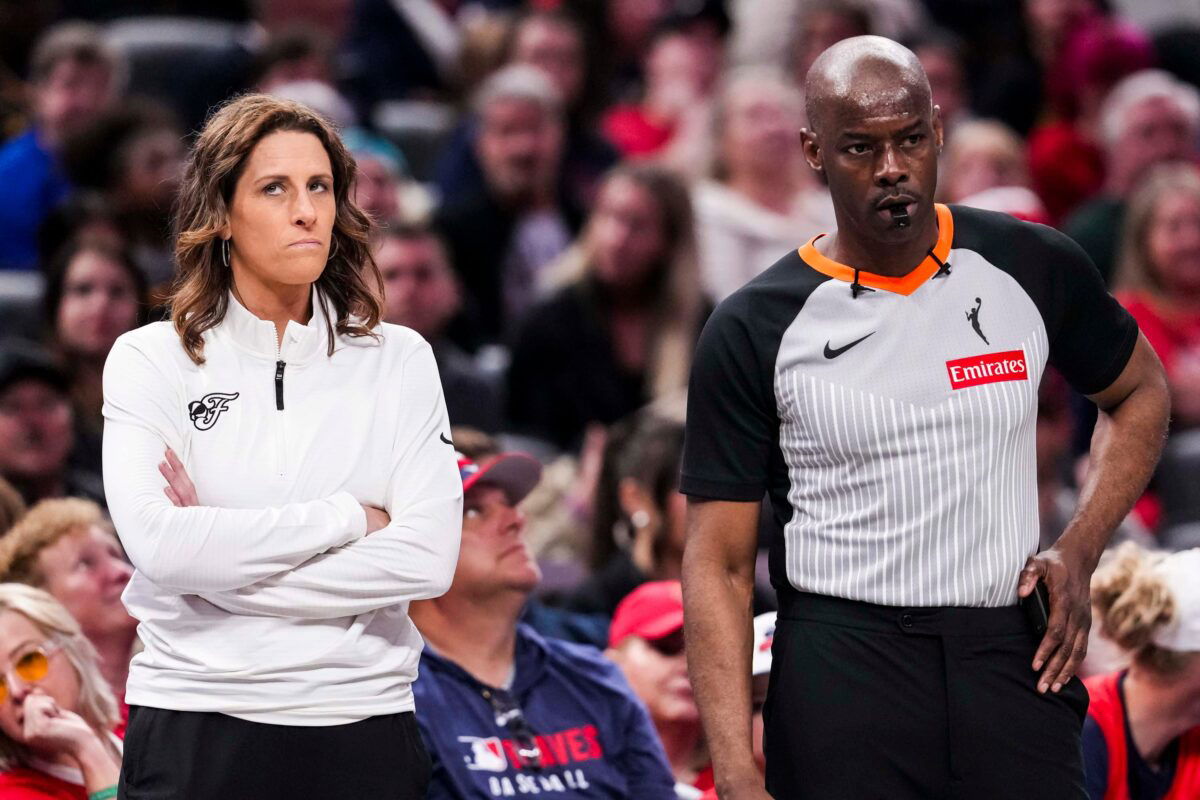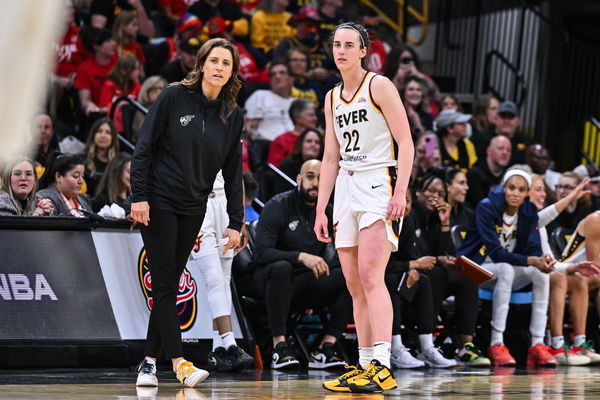
Imago
Indiana Fever head coach Stephanie White looks up Tuesday, May 20, 2025, during a game between the Indiana Fever and the Atlanta Dream at Gainbridge Fieldhouse in Indianapolis.

Imago
Indiana Fever head coach Stephanie White looks up Tuesday, May 20, 2025, during a game between the Indiana Fever and the Atlanta Dream at Gainbridge Fieldhouse in Indianapolis.
Stephanie White is not here to make friends with referees. She’s here to win basketball games and if it means ruffling a few stripes along the way—so be it. “Do you want me to get fined again?” she said post the latest Indiana Fever game. “Because I did just get fined.” But judging by her tone after the Fever’s 83-77 loss to the Mystics… she just might be ready to write another check.
Watch What’s Trending Now!
This time, though, she wasn’t fuming. She was measured—but firm. After a game loaded with borderline whistles and glaring non-calls, a reporter asked her if she thought the league should protect players from intentionally rough play. Her reply was dry but telling:
“I don’t feel like there’s any more intentionally rough play than there is in any basketball game.” Translation? That’s not the issue. The issue is consistency.
ADVERTISEMENT
“You know, it’s—are we going to say that we want a free-flowing offensive game, or are we going to have tough, grind-it-out physical games?” White asked. “And whatever way it is, the players will adjust, and coaches will adjust. But we can’t have it be one way, one quarter, another way, another quarter.”
That’s the crux of it. One minute, physicality is toughness. The next, it’s a foul—on the offense.
When asked by a reporter if she thinks the league should protect players from “intentionally rough play,” White says: “I don’t feel like there’s any more intentionally rough play than there is in any basketball game.”
Mentions wanting consistency from refs as the biggest thing. pic.twitter.com/RLmDQsqsOn
— Chloe Peterson (@chloepeterson67) May 29, 2025
ADVERTISEMENT
Take the Fever’s loss to the Liberty earlier this season. Final minute. Tie game. Lexie Hull’s whistled for a shooting foul on Sabrina Ionescu—even though Ionescu initiated the contact. That gave New York a two-point lead. Then, with 1.2 seconds left, Caitlin Clark tried to get off a shot. Natasha Cloud bodied her and clipped her with a moving leg. No whistle. Debbie Antonelli, calling the game, said it plainly: “All over Caitlin Clark.” And still—nothing.
Or go back to opening night against the Sky. With just under five minutes left in the third, Angel Reese shoved Natasha Howard to get position on the boards. As Clark reached in for the ball, her left hand extended—Reese hit the floor. A personal foul was whistled. Then upgraded to a Flagrant-1. Moments later, Reese and Aliyah Boston both drew technicals in the same sequence. One possession, three different rulings, zero clarity.
ADVERTISEMENT
Even something as routine as bringing the ball up the court isn’t safe from the chaos. In the latest Mystics vs Fever matchup, Sophie Cunningham was simply trying to get across halfcourt. Jade Melbourne cut her off. Bumped her. Again. And again. And again. No call. But the moment Sophie tried to hook her arm just to get space, boom—offensive foul.
Fans spotted it instantly. One commenter summed it up: “Two blocking fouls, possibly a third… and then they call the offensive player for hooking?”And this is exactly what makes White’s stance so compelling: she’s not whining. She’s not blaming the officials for every loss.
ADVERTISEMENT
Officiating Is a WNBA Problem, Not Just Fever’s—and Coach White’s Fighting Back
She’s coaching. She’s demanding standards. Structure. Clarity. And she’s not alone.
Rachael DeMita put it bluntly on The Courtside Club: “If we stop leaning on the fact that, ‘oh, the WNBA is just physical, get used to it’—there’s a lot of inconsistencies. And it seems like the only thing they’re trying to make consistent… are the screens.”
Even Sabrina Ionescu, not someone typically caught up in officiating debates, weighed in: “In the W, they don’t care—there are no handcheck calls—freedom of movement is different.” It’s not just Indiana. And it’s certainly not just Stephanie White. This is a league-wide issue.
ADVERTISEMENT

Imago
May 4, 2025; Iowa City, IA, USA; Indiana Fever guard Caitlin Clark (22) looks on with head coach Stephanie White during the third quarter against the Brazil National Team at Carver-Haweye Arena. Mandatory Credit: Jeffrey Becker-Imagn Images
Just look at last season’s Finals. After a crushing Game 5 loss, Minnesota Lynx head coach Cheryl Reeve let it rip: “All the headlines will read ‘Reeve cries foul.’ Bring it on. Bring it on. Because this s— was stolen from us.”And she wasn’t alone, either. Following Game 4, New York Liberty coach Sandy Brondello offered her own frustration: “I will say this—I know Cheryl said it last time, but we got no calls today.”
It was a championship series, and both coaches—on opposing sidelines—felt burned by the same fire.
Even before that, after a tough Game 2 loss, Lynx star Napheesa Collier said the quiet part out loud:
“It’s hard, you have to adjust to the refs. I mean, definitely it’s not an excuse. We played really bad… but it’s hard to adjust because you are playing one way and you are getting used to the refs and they change it up.”
That’s what Stephanie White is pushing back against. She’s not asking for favors. She’s not calling for soft play. She just wants clarity. A standard. A version of the game that doesn’t change quarter to quarter—or crew to crew. Because right now, it feels like there are 12 different versions of what “physicality” means—and 12 teams trying to guess which one the refs brought with them that night.
ADVERTISEMENT
ADVERTISEMENT
ADVERTISEMENT

